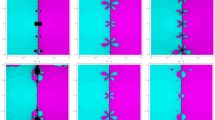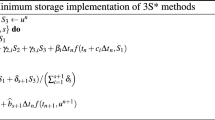Abstract
A technique for constructing nested implicit Runge–Kutta methods in the class of mono-implicit formulas of this type is studied. These formulas are highly efficient in practice, since the dimension of the original system of differential equations is preserved, which is not possible in the case of implicit multistage Runge–Kutta formulas of the general from. On the other hand, nested implicit Runge-Kutta methods inherit all major properties of general formulas of this form, such as A-stability, symmetry, and symplecticity in a certain sense. Moreover, they can have sufficiently high stage and classical orders and, without requiring high extra costs, can ensure dense output of integration results of the same accuracy as the order of the underlying method. Thus, nested methods are efficient when applied to the numerical integration of differential equations of various sorts, including stiff and nonstiff problems, Hamiltonian systems, and invertible equations. In this paper, previously proposed nested methods based on the Gauss quadrature formulas are generalized to Lobatto-type methods. Additionally, a unified technique for constructing all such methods is proposed. Its performance is demonstrated as applied to embedded examples of nested implicit formulas of various orders. All the methods constructed are supplied with tools for local error estimation and automatic variable-stepsize mesh generation based on an optimal stepsize selection. These numerical methods are verified by solving test problems with known solutions. Additionally, a comparative analysis of these methods with Matlab built-in solvers is presented.
Similar content being viewed by others
References
A. C. Guyton, Circulatory Physiology: Cardiac Output and Its Regulation (Saunders, Philadelphia, 1963; Meditsina, Moscow, 1969).
F. S. Grodins, Control Theory and Biological Systems (Columbia University Press, New York, 1963; Mir, Moscow, 1966).
G. I. Marchuk, Mathematical Methods in Immunology (Optimization Software, New York, 1983; Nauka, Moscow, 1991).
W. Nerreter, Berechnung elektrischer Schaltungen mit dem Personalcomputer (Hanser, Munich, 1987 Energoatomizdat, Moscow, 1991).
N. B. Konyukhova, P. M. Lima, M. L. Morgado, and M. B. Soloviev, “Bubbles and droplets in nonlinear physics models: Analysis and numerical simulation of singular nonlinear boundary value problems,” Comput. Math. Math. Phys. 48 (11), 2018–2058 (2008).
P. M. Lima, N. B. Konyukhova, N. V. Chemetov, and A. I. Sukov, “Analytical-numerical investigation of bubble-type solutions of nonlinear singular problems,” J. Comput. Appl. Math. 189, 260–273 (2006).
G. Yu. Kulikov, P. M. Lima, and M. L. Morgado, “Analysis and numerical approximation of singular boundary value problems with P-Laplacian in fluid mechanics,” J. Comput. Appl. Math. 262, 87–104 (2014).
P. Frogerais, J.-J. Bellanger, and L. Senhadji, “Various ways to compute the continuous-discrete extended Kalman filter,” IEEE Trans. Autom. Control 57 (4), 1000–1004 (2012).
G. Yu. Kulikov and M. V. Kulikova, “Accurate numerical implementation of the continuous-discrete extended Kalman filter,” IEEE Trans. Autom. Control 59 (1), 273–279 (2014).
G. Yu. Kulikov and M. V. Kulikova, “Accurate state estimation in the Van der Vusse reaction,” Proceedings of the 2014 IEEE Multi-Conference on Systems and Control (2014), pp. 759–764.
G. Yu. Kulikov and M. V. Kulikova, “The accurate continuous-discrete extended Kalman filter for continuous-time stochastic systems,” Russ. J. Numer. Anal. Math. Model. (2015) [in press].
M. V. Kulikova and G. Yu. Kulikov, “Square-root accurate continuous-discrete extended Kalman filter for target tracking,” Proceedings of the 52nd IEEE Conference on Decision and Control (2013), pp. 7785–7790.
M. V. Kulikova and G. Yu. Kulikov, “Adaptive ODE solvers in extended Kalman filtering algorithms,” J. Comput. Appl. Math. 262, 205–216 (2014).
N. N. Kalitkin, Numerical Methods (Nauka, Moscow, 1978).
H. J. Stetter, Analysis of Discretization Methods for Ordinary Differential Equations (Springer-Verlag, Berlin,1973; Mir, Moscow, 1978).
Yu. V. Rakitskii, S. M. Ustinov, and I. G. Chernorutskii, Numerical Methods for Solving Stiff Systems (Nauka, Moscow, 1979) [in Russian].
N. S. Bakhvalov, N. P. Zhidkov, and G. M. Kobel’kov, Numerical Methods (Nauka, Moscow, 1987).
K. Dekker and J. G. Verwer, Stability of Runge–Kutta Methods for Stiff Nonlinear Differential Equations (North-Holland, Amsterdam, 1984; Mir, Moscow, 1988).
O. B. Arushanyan and S. F. Zaletkin, Numerical Solution of Ordinary Differential Equations Using FORTRAN (Mosk. Gos. Univ., Moscow, 1990) [in Russian].
E. Hairer, S. P. Nörsett, and G. Wanner, Solving Ordinary Differential Equations. I: Nonstiff Problems (Springer-Verlag, Berlin, 1987; Mir, Moscow, 1990).
E. Hairer and G. Wanner, Solving Ordinary Differential Equations: Stiff and Differential-Algebraic Problems (Springer-Verlag, Berlin, 1996; Mir, Moscow, 1999).
V. I. Lebedev, An Introduction to Functional Analysis and Computational Mathematics (Fizmatlit, Moscow, 2005; Birkhäuser, Boston, 1997).
V. I. Shalashilin and E. B. Kuznetsov, Parametric Continuation and Optimal Parametrization in Applied Mathematics and Mechanics (Editorial URSS, Moscow, 1999; Kluwer Academic, Dordrecht, 2003).
J. M. Sanz-Serna and M. P. Calvo, Numerical Hamilton Problems (Chapman and Hall, London, 1994).
E. Hairer, C. Lubich, and G. Wanner, Geometric Numerical Integration: Structure Preserving Algorithms for Ordinary Differential Equations (Springer, Berlin, 2002).
J. C. Butcher, Numerical Methods for Ordinary Differential Equations (Wiley, Chichester, 2008).
J. C. Butcher, “On the implementation of implicit Runge–Kutta methods,” BIT 16, 237–240 (1976).
T. A. Bickart, “An efficient solution process for implicit Runge–Kutta methods,” SIAM J. Numer. Anal. 14, 1022–1027 (1977).
J. R. Cash, “On the class of implicit Runge–Kutta procedures,” J. Inst. Math. Appl. 19, 455–470 (1977).
J. R. Cash, “On a note of the computational aspects of the class of implicit Runge–Kutta procedures,” J. Inst. Math. Appl. 20, 425–441 (1977).
J. R. Cash and A. Singhal, “Mono-implicit Runge–Kutta formulas for the numerical integration of stiff differential systems,” IMA J. Numer. Anal. 2, 211–227 (1982).
R. Alexander, “Diagonally implicit Runge–Kutta methods for stiff ODEs,” SIAM J. Numer. Anal. 14, 1006–1024 (1977).
R. Alt, “Metliodes A-stables pour l’integration de systemes differentiels mal conditionnesf,” PhD Thesis (Univ. Paris, Paris, 1971).
M. Crouzeix, “Sur l’approximation des equations difi’erentielles operationnelles lineaires par de methodes de Runge–Kutta,” PhD Thesis (Univ. Paris, Paris, 1975).
M. Kurdi, “Stable high order methods for time discretization of stiff differential equations,” PhD Thesis (Univ. of California, California, 1974).
L. M. Skvortsov, “Diagonally implicit FSAL Runge–Kutta methods for stiff and differential-algebraic systems,” Mat. Model. 14 (2), 3–17 (2002).
A. Kvaerno, “Singly diagonally implicit Runge–Kutta methods with an explicit first stage,” BIT 44, 489–502 (2004).
L. M. Skvortsov, “Diagonally implicit Runge–Kutta methods for stiff problems,” Comput. Math. Math. Phys. 46 (12), 2110–2123 (2006).
L. M. Skvortsov, “Singly implicit diagonally extended Runge–Kutta methods of fourth order,” Comput. Math. Math. Phys. 54 (5), 775–784 (2014).
L. M. Skvortsov and O. S. Kozlov, “Efficient implementation of diagonally implicit Runge–Kutta methods,” Mat. Model. 26 (1), 96–108 (2014).
S. P. Nörsett, “Semi-explicit Runge–Kutta methods,” Report No. 6/74 (Dept. of Math., University of Trondheim, Trondheim, 1974).
A. Prothero and A. Robinson, “On the stability and accuracy of one-step methods for solving stiff systems of ordinary differential equations,” Math. Comput. 28, 145–162 (1974).
K. Burrage, “A special family of Runge–Kutta methods for solving stiff differential equations,” BIT 18, 22–41 (1978).
K. Burrage, J. C. Butcher, and F. H. Chipman, “An implementation of singly implicit Runge–Kutta methods,” BIT 20, 326–340 (1980).
S. P. Norsett, “Runge–Kutta methods with multiple real eigenvalue only,” BIT 16, 388–393 (1976).
J. C. Butcher and J. R. Cash, “Towards efficient Runge–Kutta methods for stiff systems,” SIAM J. Numer. Anal. 27, 753–761 (1990).
J. C. Butcher and D. J. L. Chen, “A new type of singly implicit Runge–Kutta methods,” Appl. Numer. Math. 34, 179–188 (2000).
S. P. Norsett and A. Wolfbrandt, “Attainable order of rational approximations to the exponential function with only real poles,” BIT 17, 200–208 (1977).
W. M. G. Van Bokhoven, “Efficient higher order implicit one-step methods for integration of stiff differential equations,” BIT 34–43 (1980).
G. Yu. Kulikov and S. K. Shindin, “On a family of cheap symmetric one-step methods of order four,” Proceedings of the 6th International Conference on Computational Science, ICCS 2006, Reading, UK, May 28–31, 2006, Part I, Lect. Notes Comput. Sci. 3991, 781–785 (2006).
G. Yu. Kulikov, A. I. Merkulov, and S. K. Shindin, “Asymptotic error estimate for general Newton-type methods and its application to differential equations,” Russ. J. Numer. Anal. Math. Model. 22 (6), 567–590 (2007).
G. Yu. Kulikov and S. K. Shindin, “Numerical tests with Gauss-type nested implicit Runge–Kutta formulas,” Proceedings of the 7th International Conference on Computational Science, ICCS 2007, Beijing, China, May 27–30, 2007, Part I, Lect. Notes Comput. Sci. 4487, 136–143 (2007).
G. Yu. Kulikov and S. K. Shindin, “Adaptive nested implicit Runge–Kutta formulas of Gauss type,” Appl. Numer. Math. 59, 707–722 (2009).
G. Yu. Kulikov, “Automatic error control in the Gauss-type nested implicit Runge–Kutta formula of order 6,” Russ. J. Numer. Anal. Math. Model. 24 (2), 123–144 (2009).
G. Yu. Kulikov, E. B. Kuznetsov, and E. Yu. Khrustaleva, “On global error control in nested implicit Runge–Kutta methods of the Gauss type,” Numer. Anal. Appl. 4 (3), 199–209 (2011).
G. Yu. Kulikov, “Cheap global error estimation in some Runge–Kutta pairs,” IMA J. Numer. Anal. 33 (1), 136–163 (2013).
V. I. Lebedev, “How to solve stiff systems of equations by applying explicit difference schemes,” in Computational Processes and Systems (Nauka, Moscow, 1991), Vol. 8, pp. 237–291 [in Russian].
V. I. Lebedev and A. A. Medovikov, “An explicit method of the second order of accuracy for solving stiff systems of ordinary differential equations,” Russ. Math. 42 (9), 52–60 (1998).
V. I. Lebedev, “Explicit difference schemes for solving stiff problems with a complex or separable spectrum,” Comput. Math. Math. Phys. 40 (12), 1729–1740 (2000).
J. G. Verwer, “Explicit Runge–Kutta methods for parabolic partial differential equations,” Appl. Numer. Math. 22 (1–3), 359–379 (1996).
B. P. Sommeijer, L. F. Shampine, and J. G. Verwer, “RKC: An explicit solver for parabolic PDEs,” J. Comput. Appl. Math. 88 (2), 315–326 (1997).
A. A. Medovikov, “High order explicit methods for parabolic equations,” BIT 38 (1–3), 372–390 (1998).
A. Abdulle and A. A. Medovikov, “Second order Chebyshev methods based on orthogonal polynomials,” Numer. Math. 90 (1), 1–18 (2001).
L. M. Skvortsov, “Explicit multistep method for the numerical solution of stiff differential equations,” Comput. Math. Math. Phys. 47 (6), 915–923 (2007).
J. Martin-Vaquero and B. Janssen, “Second-order stabilized explicit Runge–Kutta methods for stiff problems,” Comput. Phys. Commun. 180 (10), 1802–1810 (2009).
L. M. Skvortsov, “Explicit multistep methods with extended stability domains,” Comput. Math. Math. Phys. 50 (9), 1465–1475 (2010).
L. M. Skvortsov, “Explicit stabilized Runge–Kutta methods,” Comput. Math. Math. Phys. 57 (7), 1153–1166 (2011).
L. M. Skvortsov, “Simple technique for constructing stability polynomials for explicit stabilized Runge–Kutta methods,” Mat. Model. 23 (1), 81–86 (2011).
M. V. Bulatov, A. V. Tygliyan, and S. S. Filippov, “The class of one-step one-stage methods for stiff systems of ordinary differential equations,” Comput. Math. Math. Phys. 51 (7), 1167–1180 (2011).
G. Dahlquist, “Stability and error bounds in the numerical integration of ordinary differential equations,” Trans. R. Inst. Technol. Stockholm, No. 130 (1959).
G. Dahlquist, “A special stability problem for linear multistep methods,” BIT 3, 27–43 (1963).
G. Yu. Kulikov and S. K. Shindin, “One-leg variable-coefficient formulas for ordinary differential equations and local-global step size control,” Numer. Algorithms 43, 99–121 (2006).
G. Yu. Kulikov and R. Weiner, “Global error estimation and control in linearly-implicit parallel two-step peer W-methods,” J. Comput. Appl. Math. 236, 1226–1239 (2011).
Author information
Authors and Affiliations
Corresponding author
Additional information
Original Russian Text © G.Yu. Kulikov, 2015, published in Zhurnal Vychislitel’noi Matematiki i Matematicheskoi Fiziki, 2015, Vol. 55, No. 6, pp. 986–1007.
Rights and permissions
About this article
Cite this article
Kulikov, G.Y. Embedded symmetric nested implicit Runge–Kutta methods of Gauss and Lobatto types for solving stiff ordinary differential equations and Hamiltonian systems. Comput. Math. and Math. Phys. 55, 983–1003 (2015). https://doi.org/10.1134/S0965542515030100
Received:
Published:
Issue Date:
DOI: https://doi.org/10.1134/S0965542515030100




